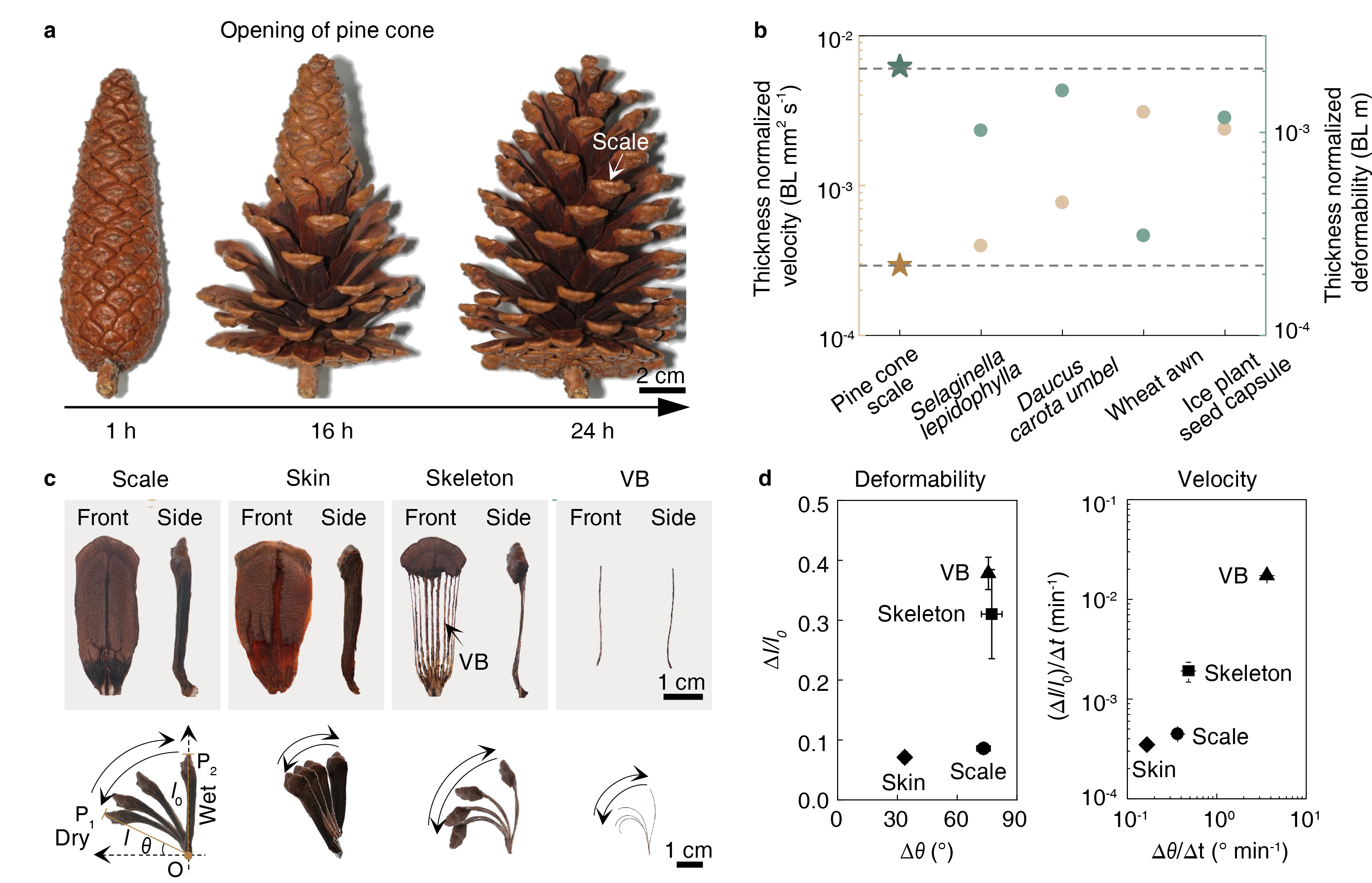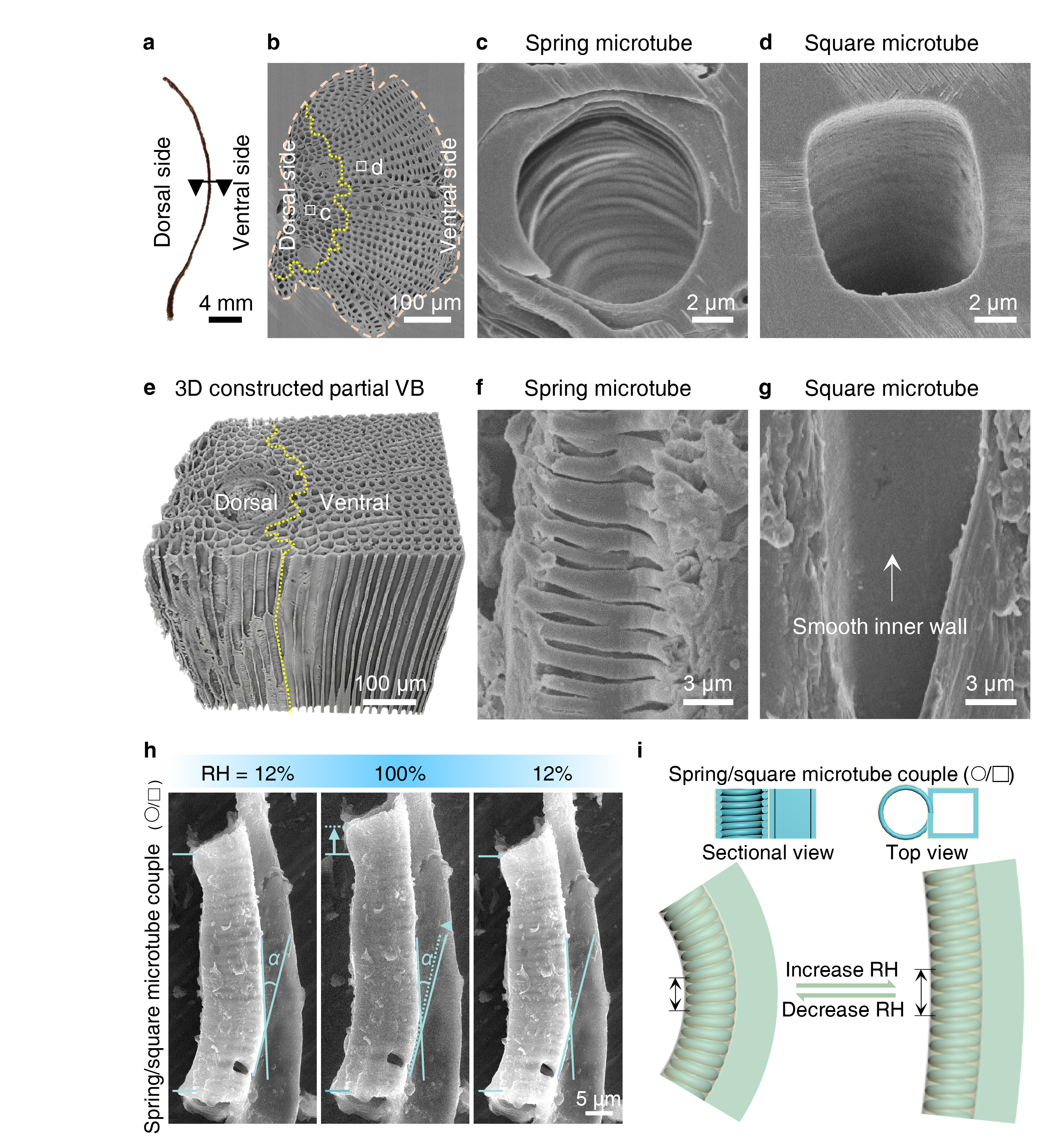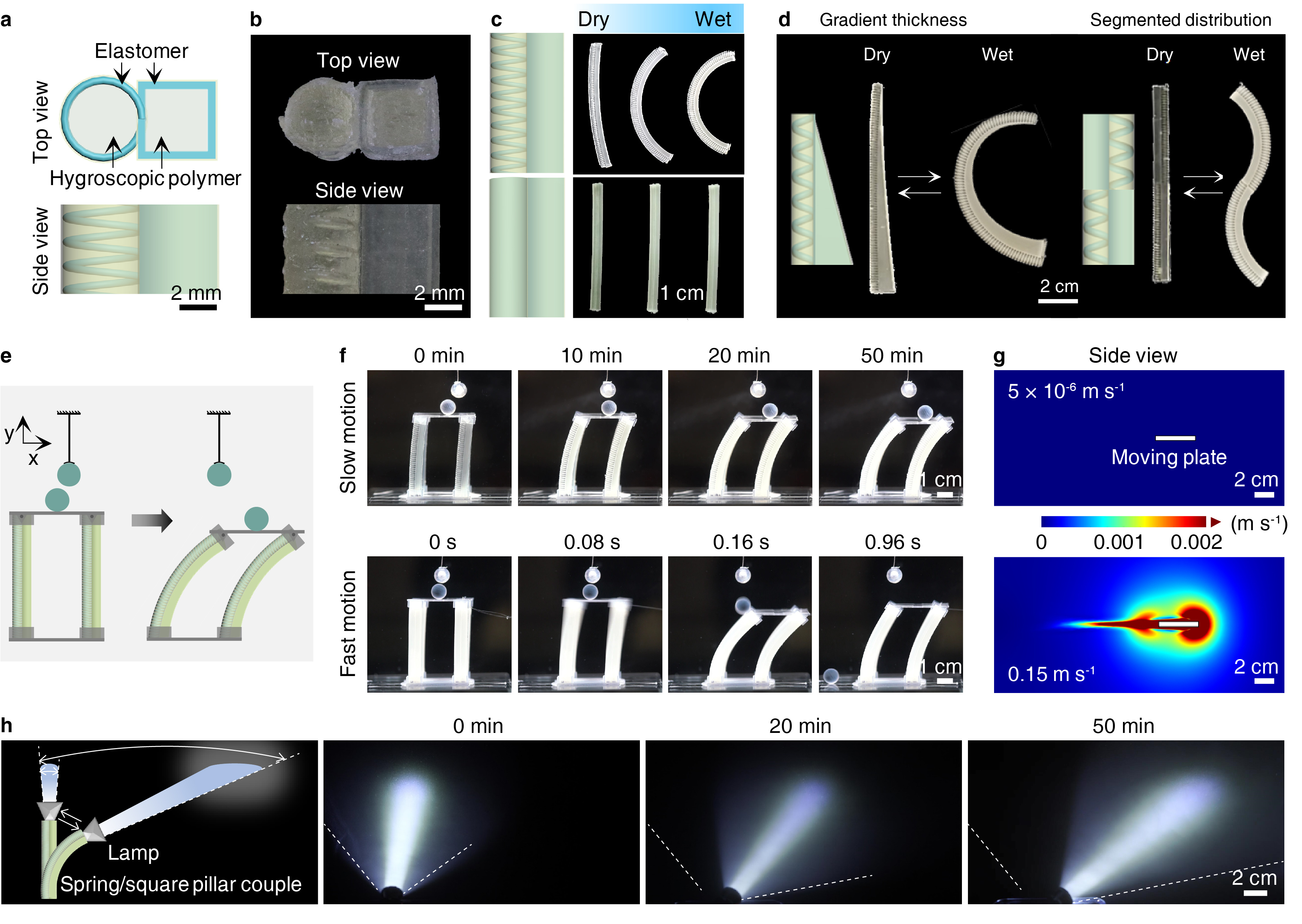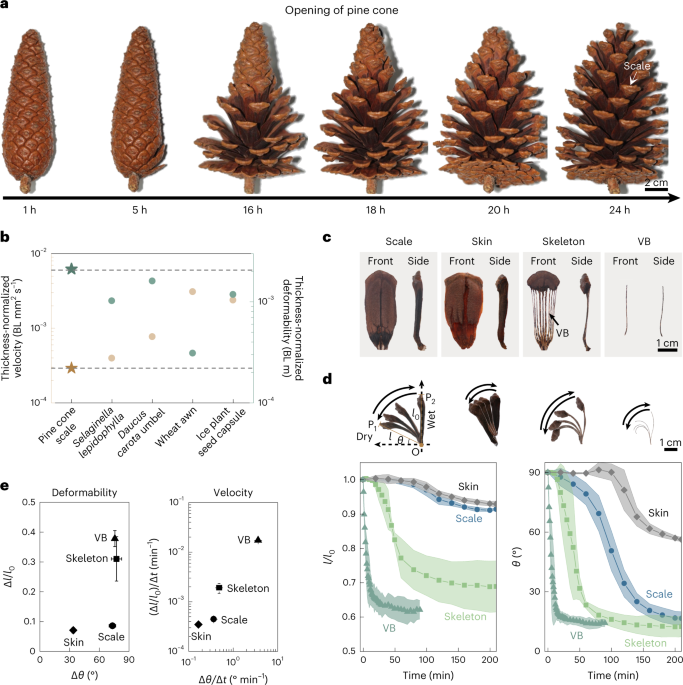Unperceivable motion mimicking hygroscopic geometric reshaping of pine cones
Published in Materials

Pine cones have given lots of inspiration to the design and fabrication of artificial actuators by virtue of the hygroscopic movement of the scales. It is generally accepted that the opening of pine cones is caused by a larger shrinkage of the bast tissues (sclereids) than of the vascular bundle (VB) tissues in the scale. However, previous research was only focused on exploring the bending mechanisms ignoring the bending process, where the pine cone opens only in a long-term dry environment for the long-distance dispersal of seeds from the parent tree by wind and animals. Therefore, the hygroscopic movement of pine cones are restudied and new phenomena, mechanism and physical model are revealed for artificial actuators with unperceivable motion.
Phenomenon & Discovery
- The hygroscopic deformation of the pine cone is an ultra-slow process.
It takes a rather long time of around 24 h for the pine cone to complete its typical geometric reshaping (Fig. 1a). As summarized in Fig. 1b, with the deformation velocity normalized by thickness, the scales of the pine cone give the lowest value among plant organisms capable of hygroscopic deformation, which is consistent with their function for long-distance seed dispersal.
- The VB itself exhibits hygroscopic deformation.
As has been reported, the scale is mainly composed of two tissues, inner VBs (assembled as the skeleton) and outer sclereid tissue (figuratively called ‘skin’ hereafter). The VB itself enables hygroscopic geometric reshaping with an even larger deformability and motion velocity than that of the scale (Fig. 1c, d), indicating their crucial role in driving the humidity-responsive motion. While both the skin and the whole scale have a much lower motion velocity than the skeleton and VBs. Similarly, the waterlogged scale and skin exhibit higher water contents and slower dehydration velocity than the skeleton and VBs.
Therefore, it can be concluded that the VBs drive the hygroscopic deformation of the scales and the sclereids (skin) with good water retention slow down the deformation.

Fig. 1 | The typical slow hygroscopic geometric reshaping of a pine cone and its hierarchical components of scale, skin, skeleton and VB. a, Opening process of a waterlogged pine cone. The waterlogged pine cone gradually opened over time at 35 °C with a RH of 30–40% and took over 24 hours to reach the fully open state. b, Summary of the deformation velocity and capability of various hygroscopic plant organisms, where the pine cone scale exhibits the smallest thickness-normalized velocity still with quite large deformability. c, Optical images of front and side views (top) and the humidity-responsive reversible bending (bottom) of the whole scale, skin, skeleton and VB. d, The deformation capability characterized by Δl/l0 and Δθ and the velocity characterized by (Δl/l0)/Δt and Δθ/Δt of the scale, skin, skeleton and VB.
The underlying mechanism of the VB deformation
- Heterostructure of spring microtubes and square microtubes
To explore the bending mechanism of the VBs, the microstructures of the VB and their hygroscopic expansion performances are investigated. As shown in the cross-sectional SEM image, the VB shows a typical heterostructure comprising two kinds of tube-like constituent cell walls with a clear boundary (Fig. 2a-d). The reconstructed three-dimensional (3D) XCT image (Fig. 2e) and longitudinal cross-sectional SEM images of the microtubes (Fig. 2f, g) further verified two kinds of microtubes, one with a spring-like structure and the other with a square-tube-like structure, in a parallel arrangement.
- Different hygroscopic expansion of spring microtubes and square microtubes
In situ observation of the hygroscopic motion of a side-by-side spring/square microtube couple from the VB was conducted using environmental SEM (ESEM) under controllable RH (Fig. 2h). With increasing RH, the spring microtube extends and thus the spring/square microtube couple bends towards the square microtube with the inflection angle α at a certain point decreasing to α′ (from the solid tangent line to the dashed tangent line, Fig. 3c). On the contrary, the microtube couple bends towards the spring microtube side as RH decreases with an increased inflection angle.
According to the above results, a simplified model of one-dimensional heterostructured spring/square microtubes was used to address the hygroscopic geometric reshaping of the VB (Fig. 2i). The model is merely heterogeneous in structure, independent of the chemical nature of the materials. With increasing RH, the spring microtube stretches and its coil pitch increases, while the square microtube with its dense structure shows only very limited change. To accommodate the difference in the length of the two microtubes, the couple bends towards the square microtube side. On the contrary, with decreasing RH, the couple bends towards the spring microtube side.

Fig. 2 | Microstructures of the single VB and the bending mechanism. a, Optical image of a single VB. The black line and triangles indicate the position for further observation. b, The cross-sectional SEM image shows that the VB (outlined with a pink dash line) is an aggregate of hollow microtubes, in which the dorsal side is approximately round microtubes and the ventral side is relatively regular rectangular microtubes. The yellow dashed line is the dividing line of the two kinds of microtubes. c, d, SEM images with increased magnification show that the inner walls of the round and rectangular microtubes are spring-like and smooth, which were defined as spring microtube (c) and square microtube (d), respectively. e-g, The inner morphologies of the spring and square microtubes. The 3D reconstructed partial VB obtained by XCT (e) shows that the inner wall of the microtubes at the ventral side is much smoother than that at the dorsal side, as divided by the yellow dashed line. The longitudinal cross-sectional SEM images of the two microtubes confirmed their spring (f) and smooth structures (g), respectively. h, ESEM images of the spring/square (○/□) microtube couple at low, high and low RH in turn. The solid and dash lines indicate the borders of the microtubes at low and high RH, respectively. The microtube couple bends towards the square microtube side with the increase of RH as indicated by the increased length of the spring microtube (from the solid line to the dashed line) and the decreased inflection angle (from the solid tangent line α to the dash tangent line α´). On the contrary, the microtube couple bends towards the spring microtube side with the decrease of RH. i, Schematic of the simplified one-dimensional hetero-structured spring/square (○/□) microtube model for hygroscopic geometric reshaping mechanism. The spring microtube shows larger deformation as RH changes due to the stretchable spring structure, while the dense square microtube keeps inert. The asymmetric hygroscopic deformation leads to the reversible bending of the microtube couple.
 Pine cone-mimicked actuators with unperceivable motion
Pine cone-mimicked actuators with unperceivable motion
Based on the simplified model, a couple of one-dimensional heterostructured spring/square (○/□) pillars by 3D printing. The spring pillar is an elastomer spring embedded in a hygroscopic material and the square pillar is an elastomer square tube filled with a hygroscopic material (Fig. 3a, b). The filled hygroscopic material endows the pillars with the capability of hygroscopic expansion and also works as the skin in the scale to increase the water diffusion path and decrease the expansion velocity. The fabricated spring/square (○/□) pillars exhibit a similar hygroscopic deformation performance as the pine cones (Fig. 3c). By virtue of the editability and compatibility of such a one-dimensional heterostructured spring/square (○/□) pillar couple with the 3D-printing technique, various elaborate shape transformations can be realized in a controllable manner by merely regulating the structures (Fig. 3d). As a proof of concept, we fabricated a table with a tabletop that moves reversibly underwater and in air to transport an object on it, using spring/square (○/□) pillars as legs (Fig. 3e, f). The table exhibits a stable motion with no disturbance to the surrounding water (Fig. 3f), as verified by the simulated result (Fig. 3g). With the artificial pillar couples as the holder, detectors also can achieve a largely increased monitoring scope with unperceivable motion (Fig. 3h).

Fig. 3 | Artificial actuators mimicking the structure of the VB via 3D printing. a, b, Schematic (a) and optical images (b) of VB-mimic spring/square (○/□) pillar couple from the top and side views. c, The pillar couple bends in wet state and recovers to straight in dry state (top), while the control sample (circular/square pillar couple without spring structure) keeps still in varied ambiances (bottom). d, Various complex shape transformation based on the 3D-printed spring/square (○/□) pillar couple. e, Schematics of moving table using spring/square (○/□) pillar couples as legs with one free ball on it and the other hanging ball above, by which the stability of table movement and disturbance to the surrounding water were evaluated. f, Photographs of a moving table at low velocity (spontaneous motion when immersed underwater) and high velocity (pulled quickly with external force), and in the former case, the ball keeps staying at the same place without observable rotating. g, Numerical simulations of the fluid flow caused by the plate with velocities of 5×10-6 and 0.15 m/s corresponding to the slow and fast motion in (f), respectively. g, A proof-of-concept for unperceivable moving detectors with largely increased monitoring scope. Left: schematic of moving lamp with artificial spring/square (○/□) pillar couple as the holder; right: selected snapshots showing the scanning scope of the lamp beam was largely increased by virtue of the moving holder.
This study offers deep insight into understanding the hygroscopic deformation of plant tissues, but also into developing responsive actuators that enable ultraslow motions.
This work has been highlighted by Prof. Cecilia Laschi ( National University of Singapore) and Prof. Barbara Mazzolai ( Istituto Italiano di Tecnologia) with a view article titled ‘Move imperceptibly’ in Nature Materials.
For more details, please check out our paper “Unperceivable motion mimicking hygroscopic geometric reshaping of pine cones”.
https://www.nature.com/articles/s41563-022-01391-2
News & Views
Follow the Topic
-
Nature Materials

A monthly multi-disciplinary journal that brings together cutting-edge research across the entire spectrum of materials science and engineering, including applied and fundamental aspects of the synthesis/processing, structure/composition, properties and performance of materials.


Please sign in or register for FREE
If you are a registered user on Research Communities by Springer Nature, please sign in